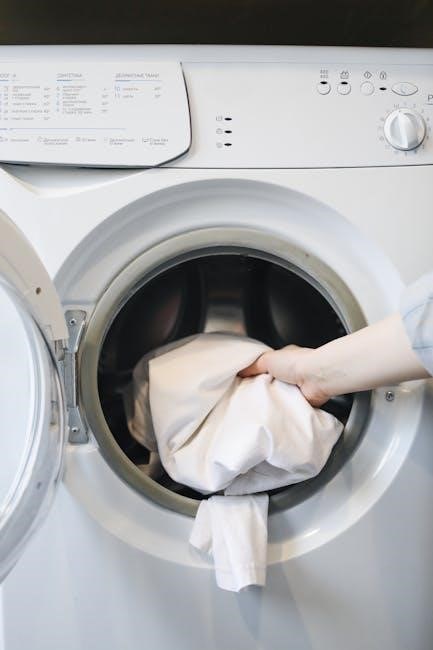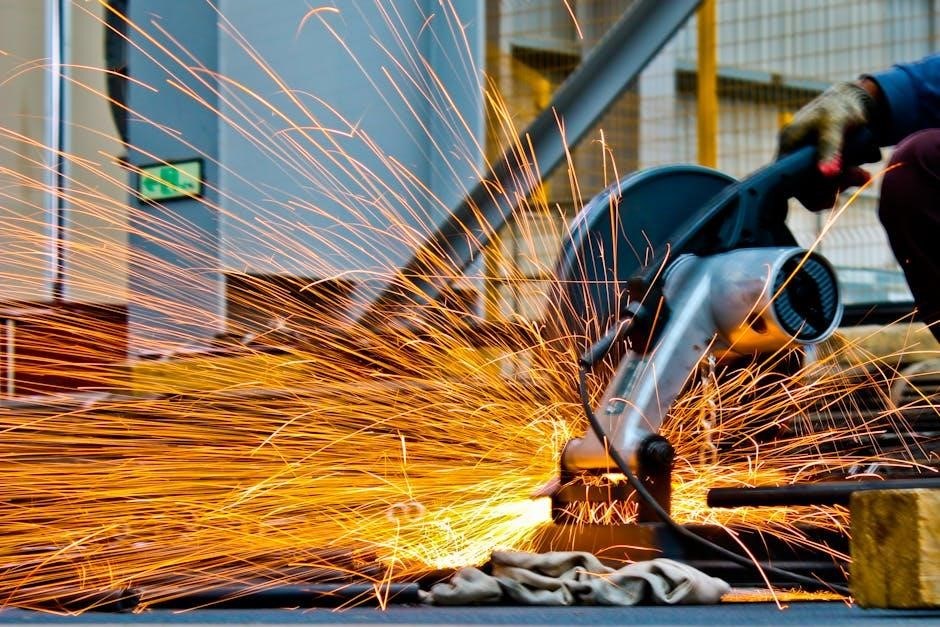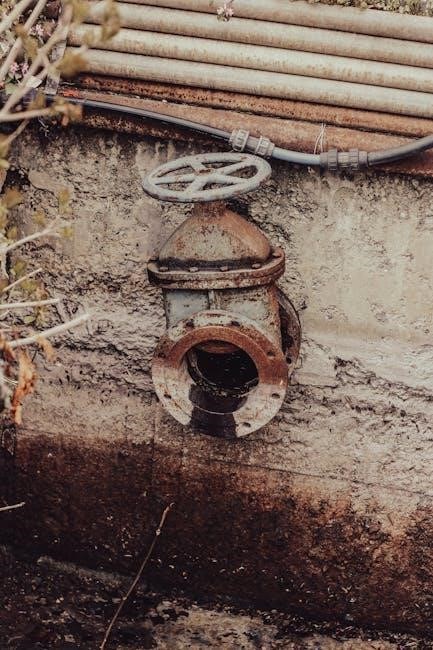Overview of Valve Manuals
Valve manuals provide essential guidance for installation‚ operation‚ and maintenance of various valve types‚ ensuring safe and efficient functionality across industrial applications.
1.1 Importance of Valve Manuals
Valve manuals are crucial for ensuring the safe and efficient operation of valves in various industrial applications. They provide detailed instructions for installation‚ operation‚ and maintenance‚ helping to prevent system failures and ensure compliance with industry standards. Without proper guidance‚ valves may not function optimally‚ leading to safety risks and potential downtime. Manuals also outline essential safety precautions‚ such as depressurizing systems before maintenance‚ to protect personnel and equipment. Additionally‚ they often include troubleshooting tips to address common issues‚ reducing the need for costly repairs. By following the guidelines in valve manuals‚ users can extend the lifespan of their valves and maintain system performance. These documents are indispensable for professionals working with industrial systems‚ offering comprehensive insights into valve functionality and care.
1.2 Types of Valves Covered in Manuals
Valve manuals typically cover a wide range of valve types to cater to diverse industrial needs. Commonly included are gate valves‚ known for their straightforward on/off operation‚ and globe valves‚ which offer precise flow control. Ball valves and butterfly valves are also frequently covered‚ as they provide quick shut-off capabilities and are ideal for large flow systems. Additionally‚ check valves are often included to prevent backflow in piping systems. Manuals may also address specialized valves like needle valves for fine-tuned flow regulation and plug valves for applications requiring minimal leakage; Some manuals extend to solenoid valves and control valves‚ which are integral to automated systems. By detailing these valve types‚ manuals ensure users can select and use the most suitable valve for their specific application‚ enhancing system efficiency and safety. This comprehensive coverage makes valve manuals indispensable resources for engineers and technicians.

Installation of Valves
Proper valve installation is crucial for system efficiency and safety. Always follow the valve manual for specific instructions. Prepare the system‚ use correct tools‚ ensure proper alignment‚ and adhere to torque specifications. Test the valve after installation to confirm functionality and prevent future issues.
2.1 Gate Valve Installation
Gate valve installation requires careful preparation and adherence to the valve manual. Begin by ensuring the system is depressurized and cleaned of debris. Mount the valve in a fully open or closed position‚ depending on the application. Use proper flange alignment to avoid warping the valve body. Tighten bolts gradually and evenly to prevent uneven stress. Apply the recommended torque specifications to ensure a leak-tight seal. Avoid over-tightening‚ as this can damage the valve or seating surfaces. After installation‚ test the valve by cycling it several times to ensure smooth operation. Inspect for leaks around flanges and stems. Regular lubrication of the stem and packing glands is essential for long-term performance. Always refer to the manufacturer’s guidelines for specific installation requirements. Proper installation ensures reliable operation and extends the valve’s service life.
2.2 Globe Valve Installation
Globe valve installation is critical for precise flow control and system performance. Begin by ensuring the system is depressurized and free from contaminants. Position the valve correctly‚ considering the flow direction and valve orientation. Use proper alignment with the piping to avoid strain on the valve body. Secure the valve using flanges or threaded connections‚ ensuring a tight seal with gaskets or sealants. Tighten bolts evenly to prevent uneven stress. Install the valve in a fully open position to facilitate initial operation. Connect the actuator or handwheel according to the manufacturer’s instructions. Test the valve for leaks and proper function. Regular inspection of the valve seat and stem packing is essential for maintaining performance. Follow the valve manual for specific torque values and installation guidelines to ensure optimal operation and longevity. Proper installation ensures accurate flow regulation and minimizes wear on internal components.
2.3 Ball Valve Installation
Ball valve installation requires careful planning to ensure proper function and system integrity. Begin by inspecting the valve for any damage or debris. Ensure the system is depressurized and clean before installation. Mount the valve in a position that allows easy access for operation and maintenance. Use compatible piping materials and connections‚ such as flanged‚ threaded‚ or welded ends‚ depending on the system requirements. Tighten all connections evenly to avoid uneven stress on the valve body. For threaded connections‚ apply Teflon tape to prevent leaks. Ensure the valve is fully open during installation to avoid interference with the ball and seat. Connect the actuator or handle according to the manufacturer’s instructions. Test the valve by cycling it several times to ensure smooth operation. Avoid over-tightening‚ as this can damage the valve’s internal components. Refer to the valve manual for specific torque values and installation guidelines to ensure optimal performance and longevity. Proper installation is crucial for reliable operation and minimal maintenance over time.
2.4 Check Valve Installation

Check valve installation is critical to prevent backflow and ensure proper fluid flow direction. Begin by verifying the valve’s flow direction‚ as indicated by the arrow on the body‚ to match the system’s flow. Install the valve in a vertical or horizontal position‚ depending on the piping layout‚ ensuring it is securely supported. Depressurize the system before installation to avoid fluid leakage. Use compatible piping materials and connections‚ such as flanged or threaded ends‚ and apply Teflon tape to threaded connections for sealing. Mount the valve in a location that allows easy access for future maintenance. Tighten all connections evenly to prevent stressing the valve.Cycle the valve manually to ensure it opens and closes smoothly. Avoid over-tightening‚ as this can damage the valve’s internal components. For detailed guidelines‚ refer to the valve manual‚ which provides specific instructions and torque values for proper installation. Correct installation ensures reliable operation and prevents potential system damage.
2.5 Butterfly Valve Installation
Butterfly valve installation requires careful preparation to ensure proper function and longevity. Begin by ensuring the valve is in the correct position‚ either fully open or closed‚ depending on system requirements. Inspect the piping system to confirm it is clean and free from debris that could interfere with valve operation. Align the valve’s flanges with the pipeline and secure them with bolts‚ tightening evenly to avoid warping. Attach the actuator or handle‚ ensuring it is properly aligned with the valve stem for smooth operation. Test the valve by cycling it several times to ensure smooth opening and closing‚ checking for leaks around the seals. Always follow the manufacturer’s instructions for specific models‚ as some may have unique requirements. Refer to the valve manual for detailed guidelines to ensure a successful installation. Proper installation is key to reliable operation and preventing potential system issues.

Operation of Valves
Valve operation involves controlling the flow of fluids by opening‚ closing‚ or partially obstructing passageways. Manual or automated controls regulate valve movement‚ ensuring efficient system performance and safety.

3.1 Gate Valve Operation
Gate valves are designed to control fluid flow by lifting a gate out of the fluid path. They are typically used for on/off control‚ as they provide minimal resistance when fully open. The operation involves turning a handwheel or lever‚ which moves the gate up or down via a threaded stem. Gate valves are bi-directional‚ meaning they can be installed in any orientation without affecting performance. The flow characteristics are straightforward‚ with the valve offering a full bore opening when fully engaged. Partial opening is not recommended‚ as it may lead to erosion or wear of the gate and seating surfaces. Proper operation ensures minimal pressure drop and efficient flow regulation in systems like pipelines‚ water treatment plants‚ and industrial processes. Regular maintenance‚ such as lubricating the stem and inspecting the seating surfaces‚ is essential for smooth operation.
3.2 Globe Valve Operation
Globe valves operate by regulating fluid flow through a movable disc that seats against a stationary ring. The valve stem‚ connected to the disc‚ is rotated to open or close the valve. When the stem is turned‚ the disc moves perpendicular to the flow path‚ creating a precise control over the fluid. Globe valves are known for their ability to throttle flow‚ making them suitable for applications requiring precise flow regulation. They are commonly used in systems where pressure drop is not a critical concern. The flow path in globe valves is more tortuous than in gate valves‚ resulting in higher resistance. These valves are typically installed with the flow entering below the disc to ensure proper operation. Regular lubrication of the stem and inspection of the seating surfaces are crucial for maintaining smooth operation and preventing leaks. Proper operation ensures efficient flow control in various industrial and plumbing systems.
3.3 Ball Valve Operation
Ball valves control fluid flow through a rotating ball with a bore that aligns with the flow path when open and perpendicular to it when closed. The valve is operated by turning a handle connected to the ball‚ typically requiring a quarter-turn to transition from fully open to fully closed. The design ensures minimal resistance when fully open‚ making it ideal for applications requiring low pressure drop. The ball valve’s operation is straightforward‚ with the handle indicating the valve’s position. Key advantages include quick operation‚ durability‚ and the ability to handle a wide range of fluids‚ including corrosive substances‚ depending on the materials used. Some ball valves feature a floating ball design‚ while others use a trunnion-mounted ball for larger sizes. Proper orientation during installation is crucial for smooth operation. Regular lubrication of the stem and sealing surfaces ensures optimal performance and prevents leaks. Ball valves are widely used in industrial‚ chemical‚ and plumbing systems due to their reliability and ease of use.
3.4 Check Valve Operation
Check valves operate automatically to prevent reverse fluid flow‚ ensuring unidirectional movement in a system. These valves feature a movable disc or piston that opens in response to forward flow pressure and closes when pressure drops or reverses. The operation is passive‚ relying on the fluid’s pressure differential rather than manual or mechanical actuation. When fluid flows forward‚ the disc lifts‚ allowing free passage. During reverse flow‚ the disc returns to its seat‚ sealing the valve to block backflow. This ensures system protection from potential damage caused by hydraulic shocks or contamination. Check valves are essential in applications like pumps‚ boilers‚ and irrigation systems to maintain flow integrity. Proper installation is critical‚ as the valve must be oriented correctly to function effectively. Regular inspection is recommended to ensure the disc moves freely and the seat remains tight‚ preventing leaks and maintaining optimal performance.
3.5 Butterfly Valve Operation
Butterfly valves operate by rotating a disc within the valve body to control fluid flow. The disc is connected to a stem and actuator‚ allowing for precise control. When the actuator rotates the stem‚ the disc moves perpendicular to the flow direction. In the fully open position‚ the disc is parallel to the flow‚ enabling maximum throughput. In the closed position‚ the disc is perpendicular‚ blocking the flow entirely. Butterfly valves also allow for throttling‚ enabling partial flow regulation by positioning the disc at an intermediate angle. The valve’s operation is typically smooth and efficient‚ with minimal resistance when fully open. These valves are widely used in applications requiring quick shut-off and precise flow control‚ such as water treatment‚ HVAC systems‚ and chemical processing. Their compact design and lightweight construction make them a preferred choice for many industrial and municipal applications. Regular maintenance ensures optimal performance and longevity.

Maintenance of Valves

Regular valve maintenance ensures optimal performance and longevity. Inspect for wear‚ clean or replace seals‚ and lubricate moving parts. Address leaks promptly to prevent further damage. Schedule routine servicing.

4;1 Gate Valve Maintenance
Gate valve maintenance is crucial for ensuring reliable operation. Regularly inspect the valve for signs of wear or leakage‚ especially around the packing and seat. Lubricate the stem and threads to prevent corrosion and ensure smooth operation. Clean or replace the packing if leaks are detected. Inspect the bonnet and body for corrosion and repaint if necessary. Always ensure the valve is fully open or closed to avoid seat erosion. Flush the valve periodically to remove debris; For severe damage‚ disassemble the valve and replace worn components. Follow the manufacturer’s guidelines for maintenance frequency and procedures. Proper maintenance extends the valve’s lifespan and prevents unexpected failures. Regular servicing also ensures optimal flow control and minimizes downtime in industrial processes. Always use approved tools and materials for repairs to maintain safety and performance standards.
4.2 Globe Valve Maintenance
Globe valve maintenance is essential for maintaining precise flow control. Regularly inspect the valve plug‚ seat‚ and packing for wear or corrosion. Lubricate the stem and plug to ensure smooth operation and prevent seizing. Replace the packing if leaks are detected‚ and clean or replace the seat if damaged. Inspect the bonnet and body for corrosion and apply protective coatings if necessary. Periodically disassemble the valve to clean and inspect internal components. Replace worn-out plugs or seats to maintain optimal performance. Always follow the manufacturer’s maintenance schedule. Use approved materials for repairs to ensure safety and efficiency. Regular servicing helps prevent leakage and maintains precise flow control. Proper maintenance also reduces the risk of valve failure during operation. Always refer to the valve manual for specific maintenance requirements and procedures.

4.3 Ball Valve Maintenance

Ball valve maintenance is crucial for ensuring reliable operation and longevity. Regularly inspect the valve for signs of wear or corrosion. Check the seats and seals for damage or leakage‚ and replace them if necessary. Clean the valve body and ball to remove dirt or debris. Lubricate the stem and ball with appropriate grease to prevent seizing. Inspect the actuator for proper function and adjust or replace it if needed. Disassemble the valve periodically for a thorough inspection and cleaning. Replace any damaged components‚ such as seats or seals‚ to maintain sealing integrity. Always follow the manufacturer’s maintenance guidelines. Use compatible materials for repairs to ensure performance and safety. Regular maintenance helps prevent leakage and mechanical failure. Proper upkeep ensures the ball valve operates smoothly and efficiently over time. Refer to the valve manual for specific maintenance recommendations.
4.4 Check Valve Maintenance
Regular maintenance of check valves is essential to ensure they function correctly and prevent backflow. Start by inspecting the valve for any signs of wear or damage. Clean the valve and its components‚ such as the seat and disc‚ to remove dirt or mineral buildup. If necessary‚ replace worn-out parts to maintain proper sealing. Check the spring for tension and adjust or replace it if it fails to close the valve effectively. Ensure the valve is properly aligned and securely installed to avoid misoperation. Lubricate moving parts if required by the manufacturer. Test the valve under operational conditions to confirm it opens and closes smoothly. Regular maintenance helps prevent leakage and ensures the valve operates efficiently. Always refer to the valve manual for specific instructions tailored to your check valve model. Proper upkeep extends the lifespan and reliability of the valve in your system.
4.5 Butterfly Valve Maintenance
Regular maintenance of butterfly valves ensures optimal performance and longevity. Begin with a thorough inspection to identify any wear or damage on the disc‚ seat‚ and stem. Clean the valve to remove dirt and debris that may interfere with its operation. Lubricate the stem and moving parts using a suitable lubricant to maintain smooth rotation. Check the alignment of the disc and seat to ensure proper sealing and adjust if necessary. Inspect and maintain the actuator according to the manufacturer’s instructions to ensure precise control. Replace any worn-out components‚ such as the seat or disc‚ to prevent leaks. Finally‚ test the valve under operational conditions to confirm its correct functioning. Proper maintenance prevents malfunctions and extends the valve’s service life. Always consult the valve manual for specific guidance tailored to your butterfly valve model.





